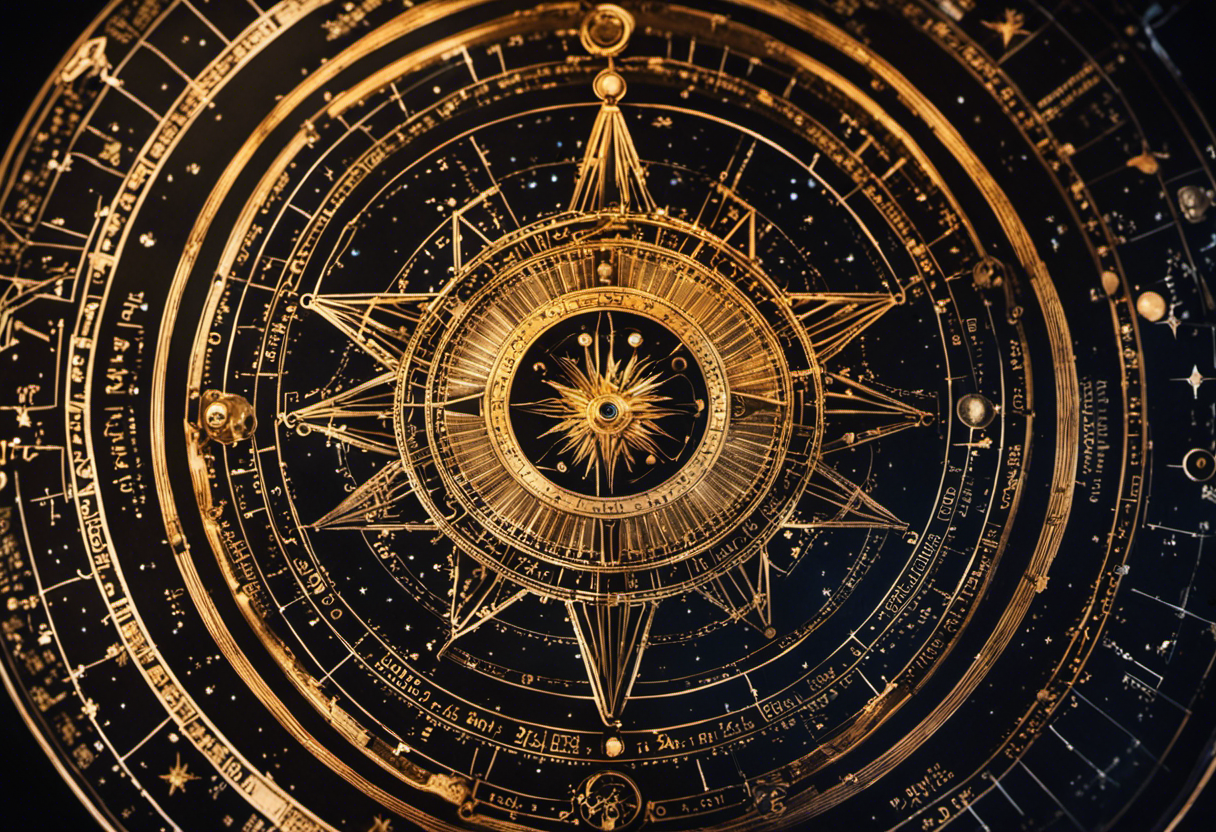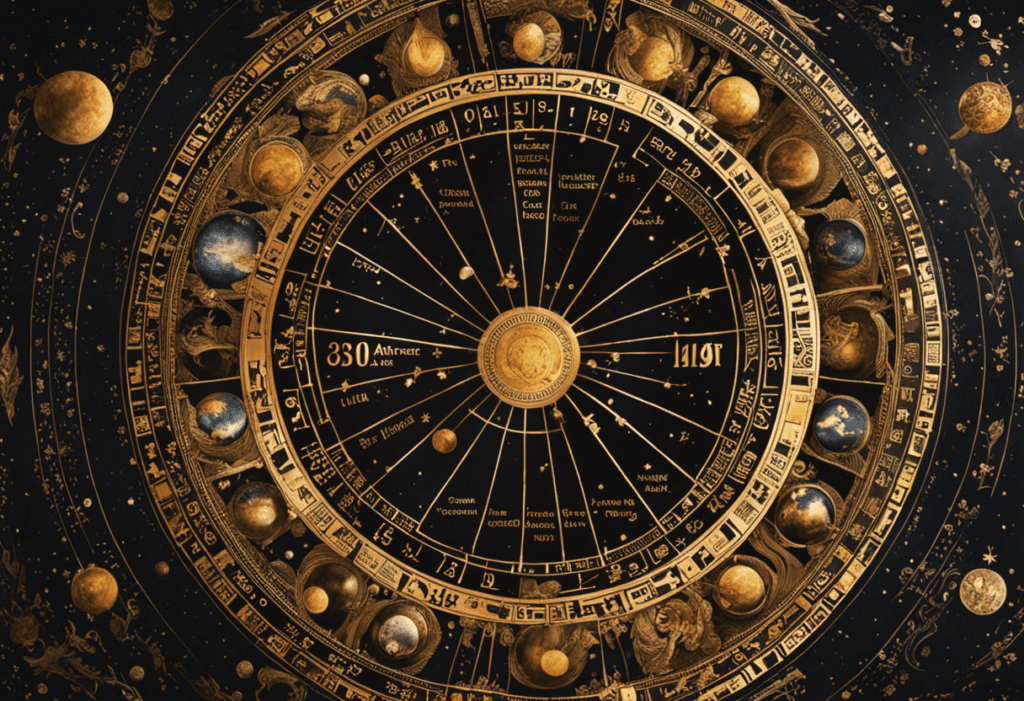Embark on a fascinating journey through time as we delve into the intricate world of the ancient Greek star calendar, known as the Parapegma.
This celestial guide, steeped in centuries of wisdom and observation, holds the key to understanding the movements of the heavens and the profound role of astronomy in ancient Greece.
Join us as we unravel the enigmatic symbols and markings, offering a unique glimpse into the secrets of ancient Greek astrology and navigating the celestial tapestry above.
Key Takeaways
- The Parapegma originated from ancient Greek astronomical practices and evolved from ancient Mesopotamian and Egyptian observations.
- The Greek Star Calendar relied on celestial observations and interpretations, dividing the night sky into constellations representing mythological figures, animals, or objects.
- Ancient star charts and celestial mapping systems allowed for predictions of seasons, astronomical events, and navigation, providing insights into ancient civilizations’ knowledge and observations.
- Celestial movements were believed to impact human affairs and fate, connecting ancient Greek culture to the universe and influencing astrology, navigation, agriculture, and religious practices.
The Origins of the Parapegma


The Origins of the Parapegma can be traced back to ancient Greek astronomical practices. The parapegma, also known as a star calendar or an astrological almanac, was a device used in ancient Greece to track the movements of stars and planets. It consisted of a wooden or stone board with inscriptions representing the constellations and celestial bodies. The purpose of the parapegma was to help astronomers and astrologers predict astronomical events such as eclipses, solstices, and equinoxes.
The evolution of the parapegma can be seen throughout history. It is believed to have originated in ancient Mesopotamia and Egypt, where early astronomers made observations of the night sky. These observations were then passed down to the Greeks, who further developed the parapegma system. Over time, different civilizations added their own interpretations and refinements to the parapegma, resulting in variations in design and content.
The parapegma played a significant role in ancient Greek society, as it was not only used for astronomical purposes but also for religious and agricultural activities. It allowed farmers to determine the optimal times for planting and harvesting crops based on the positions of the stars and planets. The parapegma was an essential tool in the hands of astronomers, astrologers, and farmers alike, offering valuable insights into the celestial world and its connection to human life on Earth.
Understanding the Greek Star Calendar


One can gain a comprehensive understanding of the Greek Star Calendar by examining its intricate system of celestial observations and interpretations. This ancient calendar relied heavily on the observation of stars and their positions in the night sky to mark the passage of time and predict various natural phenomena.
Here are some key elements that contribute to understanding the Greek Star Calendar:
- Ancient Greek Constellations: The Greeks divided the night sky into different constellations, each representing a specific mythological figure, animal, or object. These constellations served as a reference point for celestial navigation and timekeeping.
- Celestial Navigation Techniques: The Greeks developed sophisticated techniques to navigate the seas and determine their location using the positions of the stars. They observed the rising and setting of certain stars and used them as guides to navigate their ships.
- Astronomical Alignments: The Greek Star Calendar also incorporated the alignment of celestial bodies, such as the solstices and equinoxes, which helped mark significant events like the changing of seasons.
- Interpretation of Celestial Signs: The Greeks believed that celestial events, such as comets, meteor showers, and eclipses, were omens from the gods. They carefully observed and interpreted these signs to predict future events and make important decisions.
- Cultural and Mythological Significance: The Greek Star Calendar was deeply intertwined with mythology and cultural beliefs. The constellations and celestial events were often associated with specific gods, heroes, and mythical stories, adding a rich layer of meaning to the calendar.
Mapping the Celestial Movements


Astronomical mappings in antiquity played a crucial role in understanding the celestial movements and their significance. These ancient star charts were designed to track the positions of stars and other celestial bodies in the night sky, enabling observers to predict seasons, astronomical events, and even navigate the vast expanse of the heavens.
Deciphering these intricate maps provides valuable insights into the knowledge and observations of ancient civilizations and their fascination with the cosmos.
Astronomical Mappings in Antiquity
Ancient civilizations utilized intricate diagrams to illustrate the intricate dance of the celestial bodies across the night sky. These mappings were crucial for understanding and predicting celestial events, as well as for navigation purposes.
The ancient Greeks, in particular, developed a sophisticated system of celestial mapping that included the identification and naming of constellations. These constellations were used as reference points for celestial navigation techniques. By observing the positions and movements of these stars, ancient sailors and astronomers were able to navigate the seas and track the passage of time.
These astronomical mappings not only provided practical benefits, but they also served as a source of wonder and awe, connecting ancient societies to the vastness of the universe.
Significance of Celestial Movements
The mapping of celestial movements held a profound significance in understanding the interconnectedness of the universe and its impact on various aspects of ancient Greek society.
Ancient Greeks believed that celestial movements, such as the motion of the stars and planets, were closely tied to human affairs, including events, personalities, and even the fate of individuals. This connection between celestial movements and astrology was a central component of Greek culture.
Astrologers used celestial maps to predict future events and interpret the influence of the stars and planets on human lives. The impact of celestial movements on ancient Greek culture extended beyond astrology, influencing fields like navigation, agriculture, and religious practices.
Deciphering Ancient Star Charts
With careful analysis and meticulous research, scholars have been able to unravel the complex network of ancient star charts, providing invaluable insights into the intricate mapping and understanding of celestial movements.
Ancient star navigation was a crucial skill for early civilizations, enabling them to navigate the vast expanses of land and sea. Celestial navigation techniques were developed to track the positions of stars and their movements across the night sky.
Deciphering ancient star charts has shed light on the following:
- The accuracy and sophistication of ancient civilizations in mapping celestial bodies.
- The cultural and religious significance attached to specific stars and constellations.
- The practical applications of ancient star navigation in trade and exploration.
- The influence of celestial events on the development of ancient calendars and timekeeping systems.
- The connections between celestial movements and the mythology and folklore of ancient societies.
These discoveries have deepened our understanding of how ancient civilizations interacted with the cosmos and the importance of celestial navigation in their daily lives.
The Role of Astronomy in Ancient Greece


Playing a crucial role in shaping the understanding of the celestial world, astronomy held a prominent place in the ancient Greek civilization. Ancient Greek astronomers made significant contributions to both science and society.
One of the key influences of astronomy on Greek culture was its impact on mythology. The ancient Greeks believed that the movements of the celestial bodies were connected to the actions of their gods and goddesses. For example, the story of Orion, a prominent constellation, is tied to the mythological figure of Orion the Hunter. This connection between astronomy and mythology allowed the Greeks to explain natural phenomena and understand their place in the universe.
In addition to its influence on mythology, astronomy played a vital role in ancient Greek society. Greek astronomers were highly respected and often held positions of authority. They were responsible for observing and predicting astronomical events, such as eclipses and comets, which were seen as omens and used for religious purposes. Furthermore, their knowledge of astronomy contributed to advancements in navigation, agriculture, and timekeeping. The ancient Greeks developed sophisticated instruments, such as the astrolabe and the armillary sphere, to aid in their astronomical observations.
Deciphering the Symbols and Markings


An important aspect of understanding the ancient Greek star calendar is deciphering the symbols and markings used in its construction. These symbols and markings serve as a key to unlocking the knowledge embedded within the calendar, providing valuable insights into the ancient Greek understanding of celestial movements and their connection to earthly events. By decoding these symbols and interpreting their meanings, scholars are able to reconstruct the ancient Greek star calendar and gain a deeper understanding of how the Greeks perceived and measured time.
To decode the symbols and markings of the ancient Greek star calendar, researchers rely on a combination of historical records, archaeological findings, and comparative studies. By examining similar calendars from different regions and cultures, scholars can identify patterns and similarities in the symbols used, which helps in deciphering their meanings. Additionally, celestial events such as solstices, equinoxes, and the positions of specific stars and constellations play a crucial role in interpreting the markings found on the calendar.
In the process of decoding symbols and interpreting markings, researchers have uncovered fascinating insights into the ancient Greek worldview. Some notable findings include:
- The use of celestial symbols to represent gods, goddesses, and mythological figures, highlighting the Greeks’ deep connection between the celestial and divine realms.
- The inclusion of animal symbols to represent agricultural cycles and seasonal changes, reflecting the Greeks’ reliance on farming and their understanding of the natural world.
- The presence of geometric shapes and patterns, suggesting a mathematical understanding of celestial movements and the use of precise calculations in constructing the calendar.
- The incorporation of lunar phases and eclipses, indicating the Greeks’ awareness of the moon’s influence on tides, fertility, and agricultural practices.
- The depiction of celestial events in relation to significant historical events, demonstrating the Greeks’ belief in the interconnectedness of celestial phenomena and earthly occurrences.
Navigating the Night Sky With the Parapegma


By combining their knowledge of celestial movements with the information provided by the Parapegma, ancient Greek astronomers were able to navigate the night sky with precision and accuracy. The Parapegma, a stone or wooden tablet, served as a star calendar, providing important astronomical data such as the rising and setting times of stars and constellations throughout the year. This knowledge allowed the ancient Greeks to develop celestial navigation techniques that aided in their navigation at sea and on land.
One of the key aspects of navigating the night sky with the Parapegma was the identification of ancient Greek constellations. These constellations were not merely patterns in the sky, but were deeply ingrained in the culture and mythology of the ancient Greeks. By understanding the positions and movements of these constellations, astronomers were able to determine their location on Earth. This was particularly important for sailors, who relied on celestial navigation to guide their ships across vast stretches of water.
Ancient Greek astronomers also developed sophisticated celestial navigation techniques using the Parapegma. They observed the positions of stars and constellations at specific times of the year and recorded these observations on the Parapegma. By comparing these observations with the expected positions based on previous records, they could accurately determine their latitude and longitude. This enabled them to create maps and charts that were essential for navigation.
Uncovering the Secrets of Ancient Greek Astrology


Many historians and scholars have extensively researched and analyzed the ancient Greek astrological practices, yet the true extent and significance of their astrological beliefs and techniques remain largely unexplored. The ancient Greeks had a deep fascination with the stars and their movements, and they believed that the positions of the celestial bodies could reveal insights about human behavior, destiny, and the course of events.
Here are some intriguing aspects of ancient Greek astrology:
- Zodiac signs: The Greeks divided the sky into twelve sections, each associated with a particular constellation. These constellations, known as the zodiac signs, played a crucial role in determining an individual’s personality traits and destiny.
- Planetary influences: The ancient Greeks believed that the planets exerted powerful influences on human affairs. Each planet was associated with specific qualities and had both positive and negative effects on different aspects of life.
- Astrological charts: Astrologers would create personalized charts, known as horoscopes, based on an individual’s birth date, time, and location. These charts would map out the positions of the planets and interpret their influences on various areas of life, such as love, career, and health.
- Divination techniques: The Greeks employed various divination techniques, such as reading the patterns of stars and planets, to predict future events and gain insights into the unknown.
- Astrological symbolism: Ancient Greek astrology was rich in symbolism. Many constellations and celestial objects were associated with mythological figures and stories, adding layers of meaning and depth to the practice.
These ancient Greek astrological practices provide a fascinating glimpse into the beliefs and worldview of this ancient civilization. While modern science has debunked many aspects of astrology, it is still a subject of interest and curiosity, offering insights into the cultural and intellectual history of the ancient Greeks.
Conclusion
In conclusion, the ancient Greek star calendar, known as the Parapegma, is a fascinating testament to the astronomical knowledge and ingenuity of the ancient Greeks.
By deciphering the symbols and markings, we can navigate the night sky and uncover the secrets of ancient Greek astrology.
Like a celestial map, the Parapegma unveils the wonders of the cosmos, connecting us to our ancient ancestors and reminding us of the vastness and beauty of the universe.




